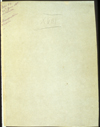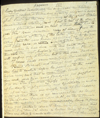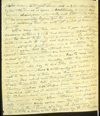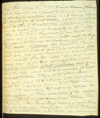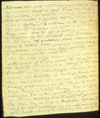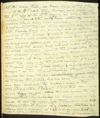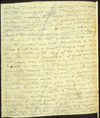Mahatma Letter No. 62
| Quick Facts | |
|---|---|
| People involved | |
| Written by: | Koot Hoomi |
| Received by: | A. P. Sinnett |
| Sent via: | unknown |
| Dates | |
| Written on: | unknown |
| Received on: | June 1882 |
| Other dates: | unknown |
| Places | |
| Sent from: | unknown |
| Received at: | Simla, India |
| Via: | unknown |
This is Letter No. 62 in The Mahatma Letters to A. P. Sinnett, 4th chronological edition. It corresponds to Letter No. 18 in Barker numbering. It is a continuation of Letter No. 61, and continues into Letter No. 63 See below for Context and background.
< Prev letter chrono
Next letter chrono >
< Prev letter Barker
Next letter Barker >
Cover sheet
|
Received Simla, June, 1882. Manvantaric chain. |
NOTES: |
Page 1 transcription, image, and notes
|
APPENDIX
|
NOTES:
|
Page 2
|
globes bearing intelligent beings — both in and out of our solar system — the crowns or apexes of evolutionary being in their respective chains, some — physically and intellectually — lower, others immeasurably higher than the man of our chain. But beyond mentioning them we will not speak of these at present. Through every race then, man has to pass making seven successive entrances and exits and developing intellect to degrees from the lowest to the highest in succession. In short, his earth-cycle with its rings and sub-rings is the exact counterpart of the Great Cycle — only in miniature. Bear in mind again, that the intervals even between these special "race re-incarnations" are enormous, as even the dullest of the African Bushmen has to reap the reward of his Karma, equally with his brother Bushman who may be six times more intelligent. Your Ethnographers and anthropologists would do well to ever keep in their minds this, unvarying septenary law which runs throughout the works of nature. From Cuvier — the late grand master of Protestant Theology — whose Bible-stuffed brain made him divide mankind into but three distinct varieties of races — down to Blumenbach who divided them into five — they were all wrong. Alone Pritchard, who prophetically suggested seven comes near the right mark. I read in the Pioneer of June 12th forwarded to me by H.P.B. a letter on the Ape Theory by A.P.W. which |
NOTES:
|
Page 3
|
contains a most excellent exposition of the Darwinian hypothesis. The last paragraph page 6 column 1 would be regarded — barring a few errors — as a revelation in a millenium or so, were it to be preserved. Reading the nine lines from line 21 (counting from the bottom) you have a fact of which few naturalists are yet prepared to accept the proof. The fifth, sixth and seventh races of the Fifth Round — each succeeding race evoluting with and keeping pace, so to say with the "Great Cycle" rounds — and the fifth race of the fifth round, having to exhibit a perceptible physical and intellectual as well as moral differentiation towards its fourth "race" or "earthly incarnation" you are right in saying that a "tremendous advance will be achieved when the fifth round people get to their seventh incarnation." |
NOTES: |
Page 4
|
(II) |
NOTES:
|
Page 5
|
See "Isis" Chapter 1, — " . . . . . the Divine Essence (Purusha) like a luminous arc" proceeds to form a circle — the mahamanvantaric chain; and having attained the highest (or its first starting point) bends back again and returns to earth (the first globe) bringing a higher type of humanity in its vortex" — thus seven times. Approaching our earth it grows more and more shadowy until upon touching ground it becomes as black as night —" i.e. it is matter outwardly, the Spirit or Purusha being concealed under a quintuple armour of the first five principles. Now see underlined three lines on page 5 for the word "mankind" read human races, and for that of "civilization" read Spiritual evolution of that particular race and you have the truth which had to be concealed at that incipient tentative stage of the Theosophical Society. See again pp. 13 last paragraph and 14 first paragraph, and note the underlined lines about Plato. Then see p. 32 remembering the difference between the Manvantaras as therein calculated and the MAHAMANVANTARA (complete seven round between two Pralayas, — the four Yugs returning seven times, once for each race. Having done so far take your pen and calculate. This will make you swear — |
NOTES: |
Page 6
|
but this will not hurt your Karma much: lip-profanity finds it deaf. Read attentively in this connection (not with the swearing process but with that of evolution) pp. 301 last line "and now comes a mystery . . ." and continue on to p. 304. "Isis" was not unveiled but rents sufficiently large were made to afford flitting glances to be completed by the student's own intuition. In this curry of quotations from various philosophic and esoteric truths purposely veiled, behold our doctrine, which is now being partially taught to Europeans for the first time.
|
NOTES:
|
Page 7
|
At the same time, we have more of the seventh ring men of the fourth race than Europe and more of the first ring of the fifth round, as, older than the European branchlets, our men have naturally come in earlier. Their being "less advanced" in civilization and refinement trouble their spirituality but very little, Karma being an animal which remains indifferent to pumps and white kid gloves. Neither your knives nor forks, operas and drawing-rooms will any more follow you in your onward progress than will the dead-leaf coloured robes of the British Esthetics prevent the proprietors thereof and wearers from having been born among the ranks of those, who will be regarded — do what they may — by the forthcoming sixth and seventh round men as flesh-eating and liquor-drinking "savages" of the "Royal Society Period." It depends on you, to so immortalize your name, as to force the future higher races to divide our age and call the sub-division — the "Pleisto-Sinnettic Period" but this can never be so long as you labour under the impression that "the purposes we have now in view would be met by reasonable temperance and self-restraint." Occult Science is a jealous mistress and allows not a shadow of self-indulgence; and it is "fatal" not only to the ordinary course of married life |
|
NOTES: |
Page 8
|
but even to flesh and wine drinking. I am afraid that the archaeologists of the seventh round, when digging out and unearthing the future Pompeii of Punjab — Simla, one day, instead of finding the precious relics of the Theosophical "Eclectic," will fish out but some petrified or vitreous remains of the "Sumptuary allowance." Such is the latest prophecy current at Tzigadze. [IV] And now to the last question. Well, as I say, the "guides" are both elementals and elementaries and not even a decent "half and half" but the very froth in the mug of the mediumistic beer. The several "privations" of such sheets of notepaper were evoluted during E's stay in Calcutta in Mrs. G's atmosphere — since she frequently received letters from you. It was then an easy matter for the creatures in following E's unconscious desire to attract other disintegrated particles from your box, so as to form a double. He is a strong medium, and were it not for an inherent good nature and other good qualities, strongly counteracted by vanity, sloth, selfishness, greediness for money and with other qualities of modern civilization a total absence of will, he would make a superb Dugpa. Yet, as I said he is "a good fellow" every inch of him; naturally truthful, under control — the reverse. I would if I could save him from. . . . NOTE. — The text continues in the next letter. — ED. |
|
NOTES:
|
Context and background
Physical description of letter
The original is in the British Library, Folio 1. According to George Linton and Virginia Hanson, the letter was written:
ML-18 (marked "Appendix") is an attachment to ML-17. It is in dark blue ink on both sides of four sheets of heavy rough paper size 10" X 11 1/2" [25.4 X 29.2 cm], very irregular in size, with the appearance of having been cut by hand. The script is heavy and somewhat different from usual.[1]
Publication history
Commentary about this letter
Notes
- ↑ George E. Linton and Virginia Hanson, eds., Readers Guide to The Mahatma Letters to A. P. Sinnett (Adyar, Chennai, India: Theosophical Publishing House, 1972), 114.
